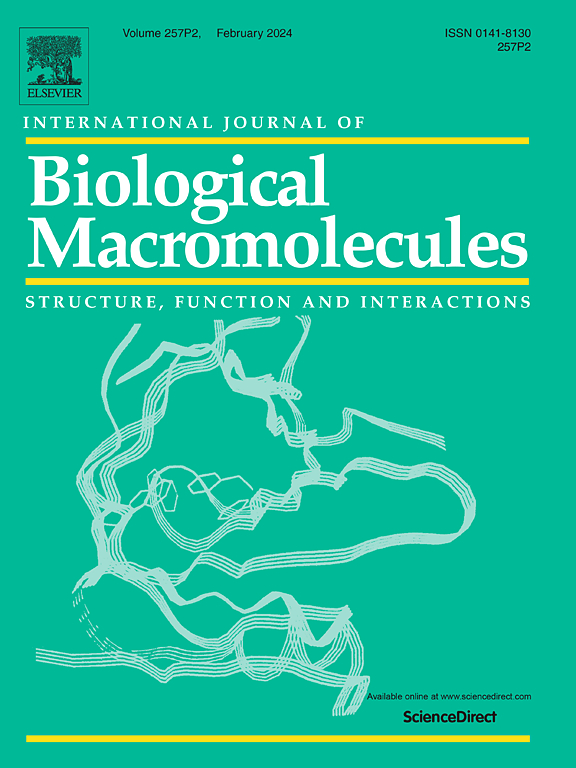Synergistic and simultaneous removal of heavy metal ions over waste bamboo shoot particles encapsulated carboxymethyl cellulose/gelatin composite hydrogel
IF 7.7
1区 化学
Q1 BIOCHEMISTRY & MOLECULAR BIOLOGY
International Journal of Biological Macromolecules
Pub Date : 2024-11-16
DOI:10.1016/j.ijbiomac.2024.137578
引用次数: 0
Abstract
Carboxymethyl cellulose (CMC) hydrogels are commonly used for heavy metal removal due to their abundant hydroxyl and carboxyl groups. However, pristine CMC hydrogels always suffer from low gel strength and limited adsorption properties in large-scale applications. In this study, to improve the gel strength and heavy metal ions removal capacity, fish gelatin and bamboo shoot particle (BSP) were introduced to CMC hydrogels, respectively. The formation of the composite hydrogel with enhanced gel strength was primarily driven by hydrogen bonding, which exhibited an increase strain resistance with a critical strain value up to 214.68 %. As expected, the composite hydrogel can effectively remove Cd2+, Hg2+, and Pb2+ from aqueous solutions simultaneously. The physical adsorption process of heavy metals by the composite hydrogel was well described by the pseudo-second-order kinetic model, while the Langmuir model indicated maximum adsorption capacities of 147.7 mg/g for Cd2+, 88.62 mg/g for Hg2+, and 163.89 mg/g for Pb2+. Notably, the composite hydrogel exhibited enhanced recyclability, maintaining its efficacy for up to at least five cycles. This study underscores the potential of using naturally occurring biodegradable materials for the removal of heavy metals, and paved ways for heavy metal removal at industrial levels.
包裹羧甲基纤维素/明胶复合水凝胶的废弃竹笋颗粒协同并同时去除重金属离子。
羧甲基纤维素(CMC)水凝胶因含有丰富的羟基和羧基而常用于去除重金属。然而,原始的 CMC 水凝胶在大规模应用中总是存在凝胶强度低和吸附性能有限的问题。为了提高凝胶强度和重金属离子去除能力,本研究在 CMC 水凝胶中分别引入了鱼明胶和竹笋颗粒(BSP)。增强凝胶强度的复合水凝胶的形成主要是由氢键驱动的,它表现出更高的抗应变性,临界应变值高达 214.68 %。正如预期的那样,复合水凝胶能同时有效地去除水溶液中的 Cd2+、Hg2+ 和 Pb2+。伪二阶动力学模型很好地描述了复合水凝胶对重金属的物理吸附过程,而 Langmuir 模型则表明其对 Cd2+、Hg2+ 和 Pb2+ 的最大吸附容量分别为 147.7 mg/g、88.62 mg/g和 163.89 mg/g。值得注意的是,复合水凝胶显示出更强的可回收性,在至少五个周期内都能保持其功效。这项研究强调了利用天然可生物降解材料去除重金属的潜力,并为在工业层面去除重金属铺平了道路。
本文章由计算机程序翻译,如有差异,请以英文原文为准。
求助全文
约1分钟内获得全文
求助全文
来源期刊
CiteScore
13.70
自引率
9.80%
发文量
2728
审稿时长
64 days
期刊介绍:
The International Journal of Biological Macromolecules is a well-established international journal dedicated to research on the chemical and biological aspects of natural macromolecules. Focusing on proteins, macromolecular carbohydrates, glycoproteins, proteoglycans, lignins, biological poly-acids, and nucleic acids, the journal presents the latest findings in molecular structure, properties, biological activities, interactions, modifications, and functional properties. Papers must offer new and novel insights, encompassing related model systems, structural conformational studies, theoretical developments, and analytical techniques. Each paper is required to primarily focus on at least one named biological macromolecule, reflected in the title, abstract, and text.

 求助内容:
求助内容: 应助结果提醒方式:
应助结果提醒方式:


